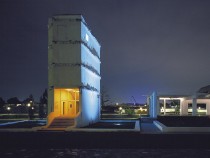
© Werner Hannappel
Designing the night with the aid of light is nothing new. Unfortunately, in the modern marketing of cities, light is exploited as a quick cosmetic means of putting on an attractive face – as a form of urban make-up. In 1966, Gyorgy Kepes wrote: “There is an age-old dialogue between man and light, and in it, light has had three major roles: cognitive, aesthetic, symbolic.” What he failed to mention was function and economy, which are today the decisive criteria for the use of light in urban situations. For economic reasons, many local authorities are turning to sodium-vapour high-pressure street lighting, for example, which produces an orange, yellow or even pink-tinged coloration and creates an almost monochromatic image at night. This may not be noticeable to car drivers, but it must be evident to anyone strolling about town with an awareness of the surroundings. Functionally speaking, city lighting is of a high standard today, but it is not very pleasing aesthetically.





